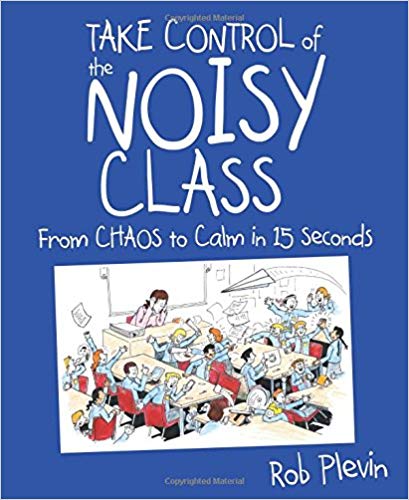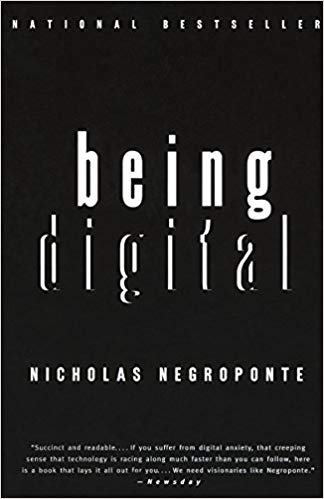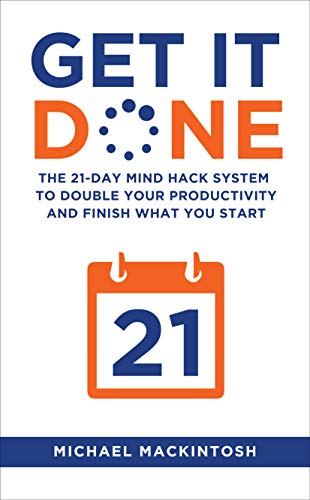Author Archive
Saturday, February 2nd, 2019
Being Digital by Nicholas Negroponte Twenty Three Years Later – It’s amazing how his vision at the time matches today’s reality. If you are looking for something cool to read, you won’t be disappointed with this classic that is still available online.
Introduction
- In 1995 Nicholas Negroponte, the founding director of the MIT Media Lab, published Being Digital. While reorganizing my library recently I picked it up and started reading it again. As I read I was amazed at how prescient his thinking was at the time. I felt that he had a very clear vision of where advances in computer technology and the Internet would take us. Much of what he predicted has come to pass while some of what he predicted has yet to happen. If he got anything wrong, I couldn’t find it to any significant degree.
Death of the Videocassette
- He saw the death of the videocassette and its associated rental businesses. He also saw services like Netflix coming due to the bandwidth of fiber and how it would be a game changer in terms of delivering content with copper serving as a stepping stone. He saw that advertising would be personalized as well. He also foresaw computers that would resemble thick pieces of paper like modern tablet computers.
- He was sad that most of the research directed at the advance of television was aimed at refining the display and increasing sizes as opposed to improving the artistry of content. He saw no reason not to expect 10,000 lines of resolution. He also predicted that computers and televisions would merge into a single device, which they have for many people as they are no longer dependent on the time of day when they want to watch something. He understood that using a lot of different fonts was a bad idea. In this case, less is more.
As For Schools
- He saw schools changing to become more like museums and playgrounds where children would assemble ideas and socialize with other children all over the world. While I’ve seen bits of this in some innovative schools, for the most part, we have a way to go to realize this vision.
- The Internet would create a totally new, global social fabric. With the Internet, schools could spend less time shoving facts into kids’ minds and more time engaging them in designing and building like they do in the maker spaces found in innovative schools. He decried the force-feeding of students’ left brains in schools that diminish the arts and other extracurriculars. Unfortunately, this has only gotten worse thanks to test-based reforms forced on schools by the federal government.
From Bits to Atoms
- He thought it was amusing that when ink is squeezed on to dead trees bits become atoms again. He saw the then-burgeoning field of multimedia as bridging the gap between science and art. He saw a day when most adults would also be computer literate. He predicted that virtual reality would allow you to put your arms around the Milky Way, swim in the human bloodstream, or visit Alice in Wonderland.
- He foresaw digital appliances with no edge at all like high-end cellphones and tablets. He saw that size would be driven by the size of pockets and watches. He said the wristwatch would migrate from a timepiece to a mobile command-and-control center as it has on my wrist thanks to my Apple Watch.
Posted in What can Dr. Doug do for you? | Comments Off on Being Digital by Nicholas Negroponte Twenty Three Years Later
Sunday, January 27th, 2019
The Formula: The Universal Laws of Success by Albert-László Barabási explains how his team discovered these laws and how they can apply to your life and the lives of those you touch. While successful people throughout the ages had no idea of why they succeeded, you don’t have to. This is certainly one of the most important books I have summarized to date. Be sure to get a copy for your school.
Introduction
- Albert and his team gathered data on people who achieved success in as many fields as possible. The assumption is that success leaves a trail of data points behind it such as publications, museum exhibits, sales, and even sports statistics. The idea was to find a series of recurring patterns that drive success in most areas of human performance. This is not about success as judged by the individual as that leaves no trail. As a result of this effort, we have the universal laws of success..
1. The Red Baron and the Forgotten Ace
- This starts with the story of Manfred von Richthofen, Germany’s ‘Red Barron’ who shot down eighty allied planes during World War I. His success was magnified by the German government and he did what he could to blow his own horn. His fame lives on thanks to Charles Schultz and Snoopy. Contrast him to René Fonck, a French pilot who may have shot down as many as 127 German planes. Fonck is an example of outstanding performance without success. He is like the opposite of Kim Kardashian. This reminds us that success and fame are very different. Albert tells stories of other people who did something first only to see a latecomer get the credit. Success, therefore, is about how you and your performance is perceived by others.
2. Grand Slams and College Diplomas
- The First Law: Performance drives success, but when performance can’t be measured, networks drive success. It’s time to see the largely invisible networks that shape our success.
- First we see that some areas like academic performance with metrics like SAT scores and GPAs and tennis with its precise ranking system are much different from most fields where accurate performance metrics don’t exist. The interesting finding here is that ambition along with performance seems to be important. Students who are rejected by top colleges like Harvard do just as well as students who go there due to their ambition. This suggests that the schools don’t really matter. It’s the student who matters.
3. The $2 Million Urinal
- Now we look at a field where there is no easy metric to judge performance, the field of fine art. Here what matters most is your network. This network is composed of curators, art historians, gallery owners, dealers, agents, auction houses, and collectors. At the center of the story is a toilet simply signed by Marcel Duchamp that sold for $2 Million dollars. Albert also points out that the Mona Lisa didn’t become the world’s most famous painting until it was stolen and wasn’t found for two years. This shows the importance of context. There is a trove of data here that contains information about where artists have shown their works. Again we see that the ambition to have your works shown in top galleries along with persistence and expanding your network are key attributes. Like students ambitious enough to apply to Ivy League schools, artists ambitious enough to promote their works to top galleries are the ones more likely to succeed.
Posted in Book Summaries, Business Books, Education Books, Leadership Books | Comments Off on The Formula: The Universal Laws of Success by Albert-László Barabási
Friday, January 18th, 2019

Token Ideas for Guest Speakers by Jenna Smith
deals with how groups and organizations can honor guest speakers. She is associated with EDCO Awards & Specialties, which is a manufacturer of corporate recognition items including crystal awards, promotional products and trophies. Be sure to check them out. Thanks Jenna.
- Finding an effective speaker is one of the most important phases of conducting a seminar or a conference. Speakers need to be notified weeks or even months in advance, especially if they are a well-known personality, an inspirational person, or someone who has a major contribution in different fields of study. Speakers are willing to take time off from their jobs, and they are looking forward to speaking in front of a large audience, lecturing about their expertise and sharing new knowledge. The audience is expected to listen to the speakers, and take down notes about the topics that they will most likely cover. At the end of every seminar or conference, the speakers are given a token of appreciation, as a form of gratitude from the organizers of the event.
- The token of appreciation is usually given in the form of an engraved plaques, but it depends on how much budget was allocated for the tokens. Most of the time, plaques are given out to speakers because they are sold everywhere. Plaques are also affordable and can be displayed on the speaker’s office to highlight the event. However, plaques are quickly becoming old fashioned, and event organizers in the present have been thinking about new ideas on what other tokens they could provide to the speakers aside from the usual plaque. The thing that can be given to a speaker varies from organization to organization, and it all boils down to how much they are willing to shell out. The following list is some of the best gifts that can be given to speakers and other guests of honor:
Personalized Items
- Anything that is personalized would be a great gift to speakers. Personalized whiskey, pens, and notebooks are some of the most common gifts handed out to speakers. Handing out a personalized item to a speaker would make them feel special, and they will highly appreciate this type of gift. One of the best tips that organizers should consider would be asking the speaker about their personal preferences so that the speaker would enjoy the gift better. Most of the time, these personalized items that are given to speakers are left untouched. These tokens end up being displayed on the speaker’s office, while others are making use of it.
Vouchers
- It might sound ridiculous to give a voucher to a speaker, but it is one of the most common trends in the world today. Vouchers for restaurants, entertainment, and experiences have become common, and most speakers will be more than happy to accept the gift. They are also looking forward to a great weekend or holidays with their family, and having a voucher on hand would be a great way to save a lot of money from paying for the entrance, food, and so much more.
Gadgets and Accessories
- For organizers who have a lot of budget for their program, they could purchase a new gadget for their speakers which they can use for further talks. However, they can also provide them with accessories that they can use, like power banks and tablet covers. Power banks and external batteries would be a great token especially if they are relying on their smartphones to discuss their topics. Having a low battery is inconvenient, but with a power bank on hand, they would never think of running out of batteries again. Tablet covers can also be a great token to speakers, and there are a lot of beautifully made products available online. Mobile speakers would also work, especially if they will be speaking in a location where speakers are limited.
Artistic Crafts
- Bobbleheads, statuettes, and caricatures are some of the best tokens that can be given to the speaker. These gifts also have a touch of personalization, and it would have a high sense of appeal to those who will be receiving it.
Old School Handwritten Note
- If the organizers do not have enough budget to buy a token of appreciation, they could make an old-style note instead. Speakers will appreciate these notes, especially if the audience will participate. Old-style notes have their own charm that makes them an ideal token for speakers. However, remember that a physical pen with a handwritten note would work best. The same charm does not work for printed letters and emails
Posted in Guest Posts | Comments Off on Token Ideas for Guest Speakers by Jenna Smith
Monday, December 24th, 2018
Get It Done: The 21-day Mind Hack System to Double Your Productivity and Finish What You Start by Michael Mackintosh offers sound advice for people prone to procrastination and who suffer from the endless disruptions that exist in our hi-tech world. If this sounds like you be sure to get a copy along with one for your school’s professional development library.
Introduction
- This book is aimed at creative entrepreneurs but I believe that educational leaders can learn from it as well. It makes very big promises, but depending on where you are it should help you focus on what’s important, increase your productivity, and finish your most important projects. It also reminds us all to build in time for rest, relaxation, and celebrating our accomplishments.
Part I – 11 Essential Mind Hacks to Make Things Happen
- 1. The Prolonged Pain or the Short-Lived Pain: If you continue doing things that are inefficient and less effective you are inviting long-term pain. Change in the near term can be painful too, but if it leads to success you won’t have to deal with it in the long-term.
- 2. The Defining Choice: Acting differently and thinking differently is a choice. Keep in mind it is the only way you are likely to get different results.
- 3. The 80/20 Rule: This rule states that 80% of your input or effort leads to 20% of your outputs or results. Therefore, the opposite has to be true that 20% of your effort leads to 80% of your results. The trick is to identify the activities that produce 20% of your output and either do them less or do them when you are not so sharp.
- 4. Good is Good Enough: The old saying “the perfect is the enemy of the good” applies here. It is important sometimes to stop when you have reached the good enough point in a job unless it’s a job that has to be perfect like a computer program.
- 5. The Delusion of Time Management: The idea here is that you only have NOW in terms of doing something. Even if you are thinking about the future you are doing it NOW. Trying to micromanage your schedule is not likely to lead to great productivity. Rather than thinking about managing time, think about managing your thoughts, words, actions, energy, and focus. As you move through the day ask if what you are doing is moving directly toward your goals. Make your most important work a priority. Organize your day to make the most of your energy. If you are a morning person like me, save the most important work for the morning. (Doug: Yes, I’m writing this in the morning.) Recognize when you are a tired, hungry, or distracted and do what it takes to recharge. It’s not how much time you put into something, it’s how much high-quality energy you invest.
- 6. The Resistance: You can’t do something new, significant, and meaningful without resistance so get ready for it. Some can come from your lower self that is comfortable with the status quo. Be alert and look for it within and without so you can take it on.
- 7. Fears and Hallucinations: Fears can be real or irrational. They can be healthy and necessary for success. They can also arise when it’s not required. Unconscious fears include the unknown, failure, and not being good enough. Once you identify them you can accept that they only exist in your mind. This should help prevent the destructive worry that come with them.
- 8. Focus: You don’t want to try to make all of your dreams come true at the same time. The idea here is to bring one idea to completion before you begin another one. Fear could be part of the problem for people who try to do too many things at once.
- 9. How to Overcome Self-Doubt: This can sabotage you before you begin. Michael suggests that you focus on the people who will be helped if you complete what you are doing and realize that self-doubt, like most fears, is also irrational.
- 10. Do It Now: Everything happens in the now, and now won’t last forever. This should help you get going and avoid procrastination.
- 11. Do Less Work to Get More Done: You don’t do your best work when you work too hard. You are more likely to make mistakes and quality is likely to go downhill. Be sure to build rest and recharge into your game plan. Sleeping on a problem or just taking a walk can help you solve it. You are also more likely to screw up your family life and other important relationships. You still have to work hard, but working too hard can even make your sick.
Posted in Book Summaries, Business Books, Leadership Books | Comments Off on Get It Done: The 21-day Mind Hack System to Double Your Productivity and Finish What You Start by Michael Mackintosh










